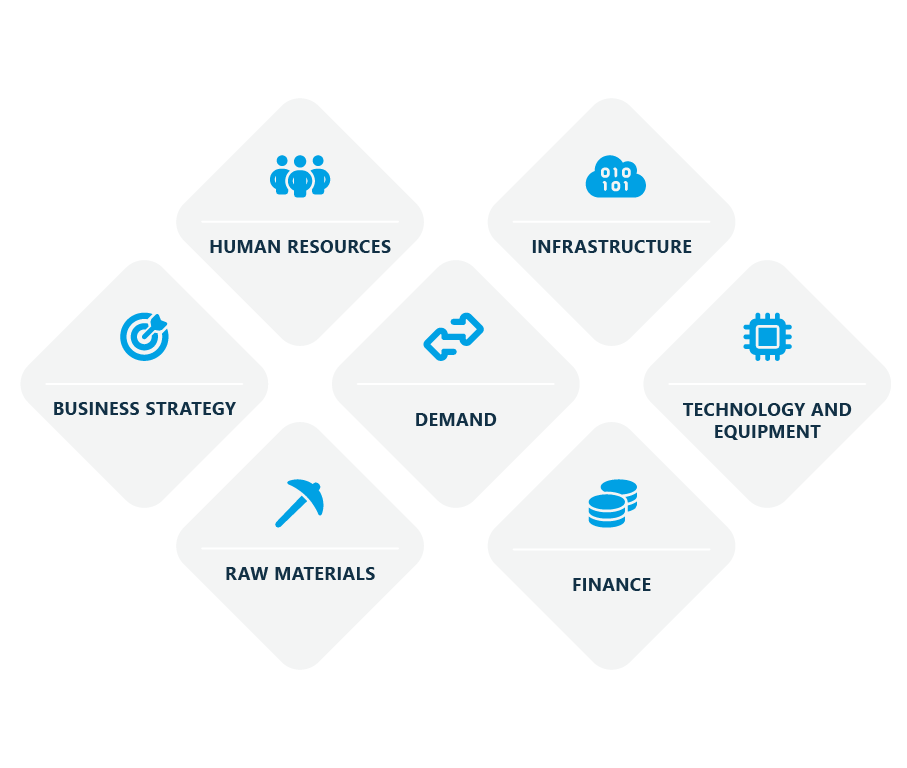Table of contents
Table of contents- Capacity planning: Do more with less
- What is capacity planning?
- What factors should be taken into account in capacity planning?
- What phases does capacity planning consist of?
- What KPIs can we use to measure the efficiency of capacity planning?
- How does capacity planning coexist and integrate with other business processes?
- Efficiency in capacity planning is a question of balance
- Capacity planning FAQs
For all companies, customer satisfaction is fundamental for success. Exceed customer expectations and you will reap the rewards of recurring income through increased loyalty and improved brand image. Better still, you can attract new customers through word-of-mouth… For these reasons, a high level of service – being able to deliver the product your customer requests in time, and to the agreed quantity – is a priority for any business.
For distributors and retailers, this means it is necessary to have sufficient capacity: stock to meet demand, a sufficient workforce, and the necessary equipment and infrastructure to achieve this. In the case of manufacturing companies, there is also the added complexity of having to carry out a process that transforms raw materials and/or semi-finished products into the final article or finished product.
In the quest to achieve these objectives, companies have a capacity that they cannot exceed due to various constraints. The higher this capacity, the more prepared the organisation will be to respond to peaks in demand without fear of losing sales. But at the same time, it will have to face higher fixed costs. To find the break-even point, there is capacity planning, which is what we will talk about in this article.
What is capacity planning?
Balance is always a virtue, and capacity planning is no exception. Planning for maximums will result in overcapacity that will cost your company dearly. By the same token, planning too “lean” may mean that you will not be able to meet demand. What you can be sure of, however, is that both situations are detrimental to your company.
Capacity planning seeks to find a balance. Therefore, we can define capacity planning as the process of determining the amount of resources needed to meet future demand for products or services. This approach seeks to balance the availability of resources with demand, ensuring that a business can operate efficiently without incurring excesses or shortages.
What factors should be taken into account in capacity planning?
The factors to be taken into account when carrying out capacity planning are diverse:

Market demand
This is perhaps the most elementary point of capacity planning, because if you have no idea what your demand will be, it is practically impossible to correctly plan the capacity you need. In order to forecast demand as accurately as possible, you should take into account historical data, market information, seasonal fluctuations, and other important metrics.
Human Resources
Your capacity as a company will also be closely related to the available hands and whether your workforce has the training and skills necessary to achieve your objectives.
Technology and equipment
In the context of capacity planning, technology and equipment play crucial roles. In the case of manufacturing companies, production capacity is directly related to the quality and condition of your machines and tools. If your equipment is obsolete or not in a good state of maintenance, your capacity will be compromised. At retailers and distributors, better technology and equipment also translates into more efficiency and therefore higher capacity.
Infrastructure
Infrastructure, which includes both the size and design of facilities, is another determining factor in capacity planning. The physical limitations of your plant, distribution centre or shops (among others) may restrict your ability to increase capacity, even if other resources are available. Efficient design can improve workflow. Assessing and planning for future infrastructure expansions is also key to ensuring that you can scale operations when needed.
Raw materials
For manufacturers, the availability and quality of raw materials is also essential for maintaining maximal production capacity. Disruptions in the supply of materials can cause production stoppages, negatively affecting the ability to meet demand.
Finance
The financial aspect cannot be ignored in capacity planning. It is necessary to ensure that financial resources are aligned with capacity plans. This includes having an adequate budget for the acquisition of machinery, hiring of personnel, and maintenance of infrastructure. The financial health of the company therefore influences its capacity.
Company strategy
Capacity planning must be aligned with the company’s overall strategy. If the strategy is for aggressive growth, capacity must be planned to support it. This implies not only having the necessary resources, but also the flexibility to adjust capacity according to market opportunities. The long-term goals of the company should guide capacity decisions to ensure everything is focused on the same objectives.
Inventory management
Inventory management is also relevant to capacity planning. Maintaining adequate stock levels ensures that demand can be met without incurring excessive costs or risks of obsolescence.
What phases does capacity planning consist of?
The capacity planning process can be divided into several phases.
Analysis of the current situation
Determine the current production capacity, including human resources, machinery, facilities, and technology. Similarly, the company’s constraints and bottlenecks should also be identified.
Demand forecasting
As mentioned above, demand forecasting is a critical phase in capacity planning. Without an accurate estimate of future demand, any capacity plan will be ineffective.
Capacity development strategies
Developing capacity strategies involves deciding how the identified capacity requirements will be met. Here, you will explore different approaches, such as increasing operational efficiency, investing in new machinery, hiring more staff, or outsourcing part of the production or other processes.
Implementation of the capacity plan
With the strategy in hand, it is time to put the plan into action. Implementing the capacity plan may involve acquiring new equipment, reorganising production lines, training additional staff, or expanding facilities. This step requires careful coordination to minimise disruption to your existing operations. To achieve this, it is advisable to have a detailed timeline and assign clear responsibilities to ensure that all aspects of the plan are executed efficiently.
Monitoring and control
Once the capacity plan is implemented, continuous monitoring and control is essential to ensure its effectiveness. This involves tracking production levels, resource utilisation, and key performance indicators (KPIs) to detect any deviations from the plan.
Review and adjustment
Capacity planning is not a static process; it requires constant review and adjustment. After a period of implementation, it is necessary to evaluate the plan’s performance and collect feedback from the different departments involved. Analyse whether production targets have been achieved and whether resources have been used efficiently. When you draw conclusions, make the necessary adjustments to the capacity plan.
What KPIs can we use to measure the efficiency of capacity planning?
Efficiency can be assessed through different KPIs that help to get an idea of how optimal an organisation’s capacity planning is:
Capacity utilisation
A metric that measures the degree to which a company uses its installed production capacity. It indicates what percentage of the total available capacity is actually being used for the production of goods or services.
A high level of capacity utilisation generally indicates an efficient operation, while a low level may suggest underutilisation of resources or potential to increase production without additional investment.
Labour utilisation
Measures the percentage of utilisation of available resources, such as employees, equipment, and space.
Use of storage space
Measures the percentage of total storage space that is actually used to store products or goods.
How does capacity planning coexist and integrate with other business processes?
Capacity planning is a process that cannot be understood in isolation. After all, it is a single cog that must be integrated with other business processes in the wider business machine to ensure effective resource management and alignment with objectives. So how does it integrate with the other processes within a company and what is its impact?
Strategic planning
- Integration: Capacity planning is aligned with the organisation’s strategic objectives to ensure that production capacity is in line with long-term goals.
- Impact: Production capacity should be able to support the company’s growth, market expansion, or product diversification strategies.
Demand planning
- Integration: Demand forecasting is fundamental to capacity planning, as it is the basis for knowing how much capacity will be needed to meet market needs.
- Impact: Allows production capacity to be proactively adjusted according to variations in demand, thereby optimising resource utilisation and minimising operating costs.
Supply chain planning
- Integration: Capacity planning must anticipate the resources that will be needed to meet demand, which involves close collaboration with suppliers and supply chain management.
- Impact: Ensures that capacity is aligned with material, component and finished product flows in the supply chain, avoiding disruptions to production.
Human resources management
- Integration: Capacity planning includes the management of the manpower required to execute the organisation’s processes.
- Impact: Facilitates the planning of staff recruitment, training and development based on capacity needs, ensuring that sufficient qualified employees are available at all times.
Financial planning
- Integration: Capacity planning has significant financial implications in terms of production costs, asset investments, and operating budget.
- Impact: Enables efficient allocation of financial resources, optimising profitability and return on investment in capacity.
Efficiency in capacity planning is a question of balance
In this blog, we have repeatedly discussed the importance of maintaining balanced stock levels to allow the company to meet demand and deliver the level of service it aims to provide while not incurring overstocking costs or excessive obsolescence risks.
Well, in the case of capacity, it is exactly the same. A lack of capacity will result in lost sales and an excess in an oversized structure that is not efficient. And it is through capacity planning that organisations can regulate their capacity to find a balance.
Capacity planning FAQs
What factors influence a company’s capacity?
Factors influencing a company’s capacity include human resources, technology and equipment, its infrastructure, availability, and its financial situation, among others.
What is the importance of capacity planning?
Capacity planning ensures a company can meet market demand without incurring excessive costs or missing sales opportunities. Capacity planning optimises resource utilisation, improves operational efficiency, and facilitates decision-making, contributing to business profitability and sustainability.
What profiles are involved in capacity planning in an organisation?
Much depends on the nature of the company’s business. However, we can consider that some of the usual profiles involved in capacity planning can be the operations manager, the production manager, the demand planning team, and the human resources manager.
What challenges may arise during the capacity planning process?
Challenges can arise during the capacity planning process, such as accurate demand forecasting, which is essential to avoid over- or under-capacity. Managing limited resources, including labour and raw materials, can also complicate planning. Unexpected changes in the market or disruptions in the supply chain can similarly destabilise projections.




